Clean Energy
Electricity has become a necessity for living a comfortable life. Today in Japan electricity is generated mainly through thermal power. However, a serious drawback to thermal power plants is their need for fossil fuels. Fossil fuels emit carbon dioxide, a major cause of global warming.
Developing new ways to produce power is critical so we can avoid damaging the earth. With new sources of power, the people living today and the people of tomorrow can continue to live comfortably, but peacefully, in our environment.
The junior writers have taken up the topic of eco-friendly "clean energy" by interviewing experts involved in researching new ways to generate power. We learned about research into several types of energy beyond such common alternatives as solar and wind power. These types of energy include power generated from unexpected sources like factory heat and microbes.
This research is the culmination of human wisdom as our species looks ahead into the future.
Clean energy today
|
10% of all power generation in Japan We asked Yoshiro Owadano, 56, Research Coordinator of the National Institute of Advanced Industrial Science and Technology in Tsukuba, Ibaraki Prefecture, about the present state of clean energy. Mr. Owadano has been engaged in energy research for 30 years. Generally speaking, clean energy describes renewable energy with minimal carbon dioxide emission. The term covers natural energy produced by water power and wind power and bioenergy generated from plants. Nuclear power emits little carbon dioxide, but it requires radioactive material that is nonrenewable and so is not considered clean energy. The reason we need sources of clean energy is because carbon dioxide and other materials discharged through the generation of thermal power are causing global warming and the fossil fuels needed for this type of energy, such as oil and coal, are being depleted. Today, clean energy accounts for about 10% of all energy generated in Japan. Of this amount, 8% consists of water power while wind, geothermal, and solar are other types of clean energy currently used in Japan. With a percentage of 10%, it can be argued, Mr. Owadano feels, that Japan is engaged in a reasonable effort to create clean energy. And in regard to solar power, Japan produces the world's second largest amount, after Germany. The problem with clean energy sources, at least at this point, is the fact that they are dependent on favorable weather. For instance, solar power cannot be generated on a rainy day while wind power must rely on wind conditions. In addition, to expand the use of clean energy, equipment must be produced at an affordable price. Technological challenges involving efficient power generation and administrative issues concerned with national subsidies for building power generation plants also exist. Other types of clean energy are being developed, too, such as energy generated from the ocean's waves or the thermoelectric effect. (Masahiro Mikoshi, 15) |
 Methods of generating power
Methods of generating power
Microbe power : producing electricity from straw
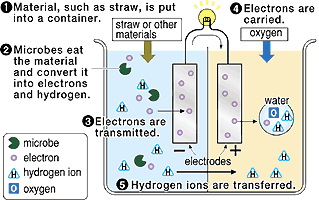
One way to generate electricity is by using microbes, including bacteria. To find out more, we spoke with Toshihide Kakizono, 49, an associate professor of Graduate School of Advanced Sciences of Matter at Hiroshima University and an expert in applied microbiology. Mr. Kakizono has studied this subject for five years and we asked him about this process and its problems.
Energy is generated by microbes through the eating of bait. When straw or some such suitable material is added to a tank containing microbes, the microbes convert this material into electrons and other elements. These electons can generate electricity.
If drainage is used instead of straw, the microbes help purify the water. Through the process of generating electricity, water and carbon dioxide are produced.
At present, the amount of electricity that can be generated is small, so further invention and experimentation is needed. However, Mr. Kakizono stresses the advantages of microbe power, pointing out that a variety of materials can serve as resources and the use of food that has passed its expiration date helps to reduce waste. Straw, since it breaks back down into the soil, is an effective and eco-friendly resource for generating power. (Moeko Takaki, 13)
| Click to hear Professor Kakizono explains about microbe power. |
Thermoelectric effect : using excess heat from cars and factories
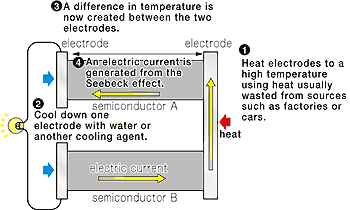
This method of generating energy uses the heat radiated from automobile engines or factories. We asked Masayuki Udagawa, 58, professor of Graduate School of Integrated Arts and Sciences at Hiroshima University and an expert in experimental physics, to explain.
Electricity can be generated by a difference in temperature. The Seebeck effect, produced by a difference in temperature between two metals or semiconductors, results in a transfer of electrons and the generation of electricity. This process doesn't require any fuel as the difference in temperature alone will create electricity.
This method, though, has its own obstacles. At present, generating continuous power raises the temperature of the cooler side, thereby decreasing the difference in temperature between the two. To fulfill the potential of this approach, finding a suitable material that can readily conduct electrons but resists transmitting heat is key.
Prof. Udagawa is uncertain if electricity can be generated on a large-scale with this method, such as a power plant. He believes, though, that it can be used in smaller ways, like generating electricity from the heat of a car's engine to power its air conditioning. It also may be possible to apply the portability of this thermoelectric effect to recharge cell phones in disaster zones. (Kotaro Tsuchida, 15)
| Click to hear Prof. Udagawa speaks about generating thermoelectric power. |
Solar power : 24 hours of energy from a satellite
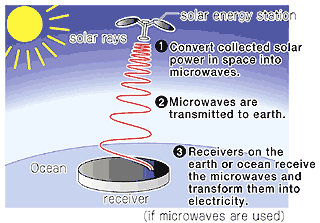
Placing solar collectors in space has the advantage of collecting 10 times as much solar energy as solar collectors set on earth. On earth, solar power cannot be generated at night and on rainy days, but in space, solar power can be collected continuously around the clock, unaffected by weather and the cycle of day and night.
We interviewed Tatsuhito Fujita, 41, associate senior engineer of the Japan Aerospace Exploration Agency (JAXA), and asked him about satellites for solar power and the challenges they present.
One key to this method is how collected energy can be efficiently transmitted to the earth. Two possibilities, using microwaves or lasers to transmit the energy to receiving plants on earth, are being investigated.
A major hurdle is the high cost. Not only must a satellite for collecting solar power be constructed--a "solar energy station"--an H2A rocket is needed to launch such a satellite, and an H2A rocket alone costs about 10 billion yen.
Moreover, a transmission test from space to earth hasn't yet been conducted; only tests on earth have been carried out. Still, researchers seek to overcome these challenges and make the concept a practical reality by about 2030. Their goal is to turn a solar energy satellite into a primary source of power generation, like thermal power and water power. (Miyu Sakata, 12)
Wave power : generating electricity from the ocean
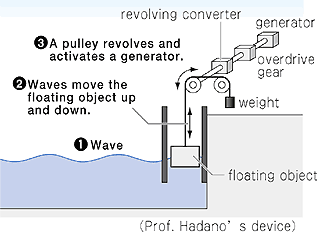
Power can also be generated by making use of ocean waves, with rotating propellers or rollers producing electricity.
Kesayoshi Hadano, 56, a professor of the Graduate School of Science and Engineering at Yamaguchi University and an expert on hydraulics and hydraulic engineering, spoke to us about wave power. According to Prof. Hadano, research on wave power generation began in France about 200 years ago, and about 100 years ago in Japan. The advantage of this method lies in the ability to generate a continuous output of electricity since ocean waves are being formed all the time. In addition, the use of this approach enables electricity to be generated even on isolated islands.
There are mainly two systems for producing power from waves: one large-scale way is using seawalls while the other employs devices in the water or on the surface of the water.
The first system involves an air chamber and propellers which are activated by the vertical movement of the ocean waves. This device can only be built when a new seawall is constructed and the cost is very high.
Other devices, for use in the water or on the water surface, are rather fragile and do not hold up well under the force of strong waves.
Prof. Hadano has invented a new device, a cylindrical object made of iron that is suspended by wire and floats on the water. The object is moved vertically by the waves, activating the wire which moves a roller. The roller revolves in only one direction so it can generate power more efficiently than conventional methods.
He plans to try this method on a Korean island which currently has no electricity. (Minako Iwata,15)
| Click to hear Prof. Hatano describes wave power generation. |

| Water power ¥11.9 | Solar power ¥47 | Wind power ¥10 | 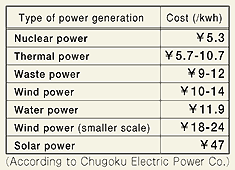 |
| To popularize these methods, the high cost must be overcome. | |||
|
The Chugoku Electric Power Company has begun using water power, solar power, and wind power generation. However, to use these methods more widely, the costs involved must be controlled. Haruyoshi Chiba, 52, manager of the corporate planning division, says that the least expensive method is waste power generation, which activates turbines from steam emitted by an incinerator. This costs from ¥9 to ¥12 to generate 1kw per hour, compared to solar power generation at ¥47. Thermal power costs from ¥5.7 to ¥10.7, so it can be said to be pretty high cost.(Rika Shirakawa, 12) | |||
